
The Deutsche Reichsbahn-Gesellschaft's BR 01 steam locomotives were the first standardised (Einheitsdampflokomotive) steam express passenger locomotives built by the unified German railway system. They were of 4-6-2 "Pacific" wheel arrangement in the Whyte notation, or 2′C1′ h2 in the UIC classification. The idea of standardisation was that it would reduce maintenance costs; i.e. if a BR 01 whose engine shop was in, say, Berlin broke down in Dresden, instead of having to ship the necessary part from Berlin and take the locomotive out of service, a part from the Dresden shop could be used as all of the engines, parts, and workings were exactly the same and produced nationwide. Thus it was a "standard" product for engine shops.
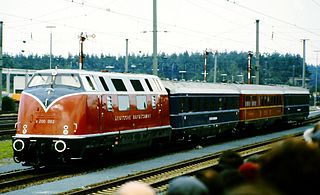
DB Class V 200 was the first series production diesel-hydraulic express locomotive of the German Deutsche Bundesbahn and – as Am 4/4 – of the SBB-CFF-FFS in Switzerland.

The DB Class 66 was a class of two Deutsche Bundesbahn (DB) locomotives designed for fast goods train and passenger train services on the main and branch lines of Deutsche Bundesbahn (DB), the national railway of the former West Germany.
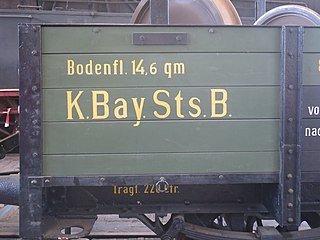
The Royal Bavarian State Railways was the state railway company for the Kingdom of Bavaria. It was founded in 1844. The organisation grew into the second largest of the German state railways with a railway network of 8,526 kilometres by the end of the First World War.

The DRG Class 86 was a standard goods train tank locomotive with the Deutsche Reichsbahn-Gesellschaft. It was intended for duties on branch lines and was delivered by almost all the locomotive building firms working for the Reichsbahn. From 1942 it was built in a simplified version as a 'transitional war locomotive'. The most obvious changes were the omission of the second side windows in the cab and the solid disc carrying wheels.

The Nuremberg Transport Museum in Nuremberg, Germany, consists of Deutsche Bahn's DB Museum and the Museum of Communications. It also has two satellite museums at Koblenz-Lützel and Halle. The Nuremberg Transport Museum is one of the oldest technical history museums in Europe and is a milestone on the European Route of Industrial Heritage (ERIH).

The German Steam Locomotive Museum or DDM is located at the foot of the famous Schiefe Ebene ramp on the Ludwig South-North Railway in Neuenmarkt, Upper Franconia. This region is in northern Bavaria, Germany. The DDM was founded in 1977.

German Kleinlokomotiven like the DRG Kö II were developed as locomotives with a low weight and driving power for light shunting duties. There were two classes, based on engine power. The Class II were engines which developed more than 40 HP.

The Uerdingen railbus is the common term for the multiple units which were developed by the German firm of Waggonfabrik Uerdingen for the Deutsche Bundesbahn and private railways after the Second World War. These vehicles were diesel-powered, twin-axle railbuses of light construction. The diesel motors were built into the chassis underneath the vehicle. The VT 95 and VT 98 of the former Deutsche Bundesbahn in particular, are associated with this concept. These vehicles were employed in passenger train duties on branch lines where steam or diesel train operations were less profitable. Including the units built under licence, a total of 1,492 power cars were built from 1950 to 1971; and the total number of units, including trailer and driving cars, was 3,306.

These DB Class V 100 diesel locomotives were produced in the late 1950s by the Deutsche Bundesbahn for non-electrified branch lines as a replacement for steam locomotives. The V 100 class was built in three different variants.
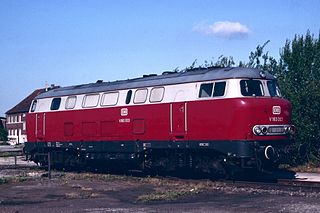
The Class V 160 is a class of diesel-hydraulic locomotives of the German railways. It is the first variant of the V160 family, built for the Deutsche Bundesbahn for medium/heavy trains.
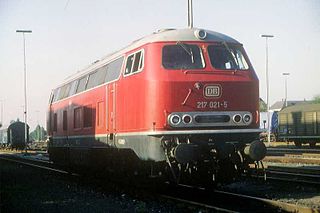
The DB Class V 162 is a class of four-axle diesel hydraulic locomotive built as a development of the DB Class V 160 for the Deutsche Bundesbahn from 1965 to 1968.

The DB Class 218 are a class of 4-axle, diesel-hydraulic locomotives acquired by the Deutsche Bundesbahn for use on main and secondary lines for both passenger and freight trains.

The DB Class V 60 is a German diesel locomotive operated by the Deutsche Bundesbahn (DB) and later, the Deutsche Bahn AG, which is used particularly for shunting duties, but also for hauling light goods trains. Seventeen locomotives were bought used by the Norwegian State Railways and designated NSB Di 5. Also the Yugoslav Railways bought used units, and designated them JŽ 734; they were subsequently designated Series 2133 by the Croatian Railways.
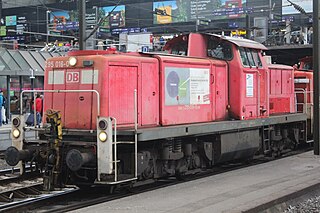
The DB Class V90 locomotive is a German road switcher diesel-hydraulic locomotive for shunting and freight hauling.

The Class 210 of the Deutsche Bundesbahn (DB) consisted, briefly, of a series of eight diesel locomotives, with a top speed of 160 km/h intended for operations on express trains. The locomotives were peculiar in that an additional gas turbine engine was able to provide extra power when needed. The additional turbine made it, at the time, the strongest four-axle German diesel locomotive.
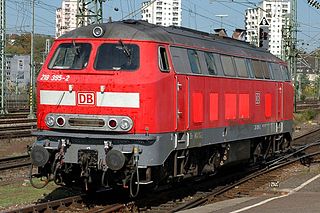
The DB V 160 locomotive family comprises several classes of closely related 4-axle diesel-hydraulic locomotives built in the 1960s and 1970s for the Deutsche Bundesbahn which take the family name from the earliest built model: the 'DB Class V 160'.

The diesel-hydraulic locomotive ML 2200 C'C' was a 6 axle variant of the DB Class V 200 series of locomotives, which were built for Yugoslav State Railways (JDŽ) by manufacturer Krauss-Maffei.

The DB Class 202, also commonly referred to under its manufacturers' designation Henschel-BBC DE2500, since it was only in experimental use and never purchased by the DB, is a class of diesel-electric locomotives designed for use on main and secondary lines for both passenger and freight trains.

The DR Class V 180 of Deutsche Reichsbahn was a class of the largest diesel locomotives built in the German Democratic Republic. The manufacturer was Lokomotivbau Karl Marx Babelsberg (LKM).






















